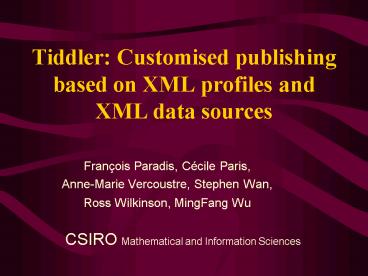Tiddler: Customised publishing based on XML profiles and XML data sources - PowerPoint PPT Presentation
1 / 24
Title:
Tiddler: Customised publishing based on XML profiles and XML data sources
Description:
Telephone Area Code: 03. Events. Major Mitchell. Output: Web Version. Virtual Document Planner: ... Document Rules not in a program language code ... – PowerPoint PPT presentation
Number of Views:195
Avg rating:3.0/5.0
Title: Tiddler: Customised publishing based on XML profiles and XML data sources
1
Tiddler Customised publishing based on XML
profiles and XML data sources
- François Paradis, Cécile Paris,
- Anne-Marie Vercoustre, Stephen Wan, Ross
Wilkinson, MingFang Wu
CSIRO Mathematical and Information Sciences
2
Outline
- Motivation
- Examples
- Current approaches
- Our approach
- How it works?
- Analysis and Conclusion
3
Motivation Why customised publishing?
- Too much information people want less
information but more relevant to their need,
knowledge, or task - On different devices at different times
paper, Web, WAP - (To build customer relationship)
4
Examples
- Customised Travel Guides
- Depending on who (preferences), where to go ,
when to go, - Depending on when/where to use it
- Corporate brochures
- Depending on who you are and your current
interest(s)
5
Current techniques
- Distinct versions of manually crafted documents
one for printing, one for the Web. No
personalisation - Word - HTML Latex - HTML HTML- WAP
- Information Retrieval personalisation through
queries, synthesis of the results no much
coherence - Document generation from database queries and
different stylesheets coherence but not high
level semantic of the resulting document. Limited
type of sources - Document generation using NL techniques relies
on the availability of knowledge base in
appropriate format
6
Tiddler approach
- Exploits both language generation and IR-document
synthesis approaches - Coherence preserved
- Wide variety of data sources (including web
pages) accessible - Dynamically plan documents
- Customise information using user models
- Generate documents for multiple media types
(Paper, Palm Pilots, Web browsers, Mobile Phones)
7
System Architecture
Virtual Document Planner
NORFOLK
Content Planner
Discourse Rules
Presentation Planner
Surface Generator
Customised Documents
8
User Model
- Include
- preferences,
- information need,
- Context (device)
- historic
- Collected via a G.U.I. Interface
- Used to
- customise information to user
- determine layout and content detail depending on
media - encapsulate some Users Goal
- Goal is about information need
- Virtual Document Planner resolves goal using
Planning techniques
9
Input User Model
- Name Zoe
- Medium Palm Pilot
- Destination Melbourne
- Date 1 June-15 June 2001
- Activities Cycling, Opera, Major Mitchell
- Travel Information
- Accommodation (backpacker)
10
XML Representation
Zoe
Melbourne
01 June
2001
15 June
2001
Cycling, Opera, Major
Mitchell
Backpackerange
palm-pilot .
11
Output Palm Pilot Version
12
Output Web Version
13
Virtual Document PlannerOverview 1
- The Virtual Document Planner
- uses Planning Techniques
- Goal achieved by finding subgoals that satisfy it
- Subgoals are linked by rhetorical relations
- Subgoals satisfied by
- other decomposable subgoals
- primitive subgoals
14
Virtual Document PlannerOverview 2
- The Virtual Document Planner
- produces a branching tree structure
- Node information need goal
- Nodes in branches subgoals
- Nodes linked by rhetorical relations
- Subgoals and Goals represent
- content selection
- presentation decisions
15
Tree for Zoe Example
Enablement
Preparation
Background
Title, Source
Joint
Further Contact
General Information
Joint
Hotels
Opera
Cycling
Major Mitchell
16
Virtual Document Planner Sub-stages
- Three substages
- The Content Planner
- The Presentation Planner
- The Surface Generator
17
Virtual Document Planner Sub-stage 1
- The Content Planner
- uses Goal Planning
- produces a tree structure
- nodes document content
- Branches rhetorical relations that may be
realised with discourse markers
18
Virtual Document Planner Sub-stage 2
- The Presentation Planner
- Leaves of the tree chosen content
- Leaves expanded with layout mark-up of document
- Mark-up depends on document organisation
- Customised for particular media type.
19
Virtual Document Planner Sub-stage 3
- The Surface Generator
- Dependent on medium
- Content and layout mark-up are mapped to
- text
- XML
- HTML
- WML
- Natural Language
- graphics
- pictures
- tables
- lists
20
Data Sources
- Norfolk technology
- provides interface between
- Virtual Document Planner
- Data sources
- Data Sources originate from
- corporate data bases
- existing web pages of known layout (wrapping)
- Data Sources can be
- static Norfolk retrieves content in advance -
XML - dynamic Norfolk retrieves content as needed by
Virtual Document Planner
21
Why are Dynamic Documents useful?
- A document can
- be composed using most up-to-date information
- customise information to user
- tailor content to particular query
- tailored to a particular media
22
What are the limitations of current dynamic pages?
- Dynamic pages are often
- statically planned with templates and stylesheets
- Templates grow exponentially in number as
document becomes more flexible - represented in program language code
- makes maintenance more difficult
- limited to filtering at document level for
customisation - required to maintain separate templates for
different media
23
Conclusions (1)
- Tiddler Advantages
- Easier to maintain because
- Documents use goal planning, not template based
- Document Rules not in a program language code
- Customisation filters and uses relevant
information from parts of documents - Information can be gathered from multiple
sources - Documents for different media are generated from
the same document skeleton - Only need to update the skeleton
24
Conclusions (2)
- Future Work
- - Reasoning about the discourse to provide
feedback/explanations - - Dynamic and complex user model to deal
with history of information delivery - - Complex user model to build customer
relationship































